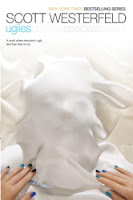Who Gets to Decide What's Pretty?
Scott Westerfeld successfully explores the societal ideal ofbeauty in his thought-provoking futuristic novel, Uglies, which is thefirst book in a series (Uglies, Pretties, Specials, Extras). Inbrief, Tally Youngblood is nearly 16 and has been waiting her entire life to be"pretty." She, like all individuals in the novel, are consideredugly, living apart from polite society, until their 16th birthday when anoperation changes them into some acceptable, predetermined form of pretty.
Told completely from Tally's point of view, we’re immersedinto her thought process and watch it change when she meets Shay who has acompletely different philosophy about prettiness, although it appears no onehas a choice. As Tally reconsiders her entire point of view, we learn there is aconsequence to changing your physical appearance. The word “shallow,”immediately leapt into my mind when I discovered the cost.
Although this can properly be labeled a young adult novel,adults may find it intriguing as well.
What meaning does beauty have and do we overvalue it? Do wemake mistakes about labels of pretty and ugly? Do these translate into ourperspectives about fatness or thinness? What about red hair or blonde hair? Shortor tall? Do these ideas split our society into two groups, as the novelsuggests?
The questions Tally has in her life are ones we start askingourselves while reading the novel. So while the plot is engaging and entertaining,filled with tension and conflict, it is also Westerfeld’s commentary on a sliceof our culture.
The book does leave me with a bigger question. Can commonsense overcome Madison Avenue? What do you think?
You have finished reading “When You’re Pretty, Do You Have aBrain?” Please consider leaving a comment.
2 Comments on When You're Pretty, Do You Have a Brain?, last added: 4/24/2012
Display Comments
Add a Comment




Holly, this is a series that I've been wanting to check out. I think this hits home for so many teens and adults--we all struggle with how we look. How can we not when we turn on the TV or even read a magazine? Thanks for sharing this and reminding me about it!
Thank you for your comment. He raises big questions about all those things. I, myself, am still left with some unanswered. I like books that make me think in that way. By the way, when you read, do so with a hard copy. I listened to one on audio and the reader is terrible. I checked to see if she reads them all, and she does. T
Holly